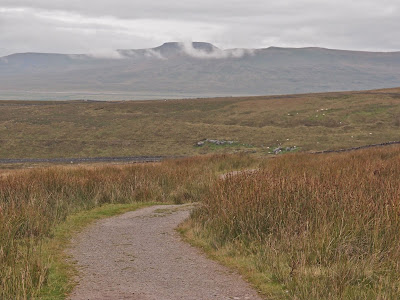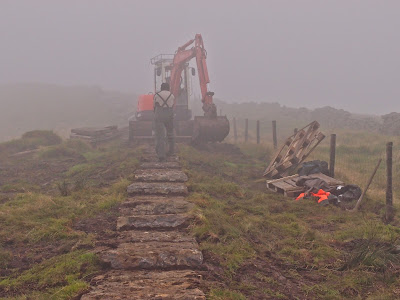 |
| Carn Mor Dearg from the Aonach ascent |
Monday, 30 September 2013
Ascent: 1835 metres
Distance: 19 kilometres
Time: 6 hours 21 minutes
t Carn Dearg Meadhonach 1179m 1hr 57mins
m Carn Mor Dearg 1220m 2hrs 10mins
Bealach Coire Giubhsachan 820m 2hrs 51mins
m Aonach Beag 1231m 3hrs 45mins
m Aonach Mor 1221m 4hrs 15mins
A reasonable forecast got me thinking, should I go to Fort William and climb Carn Mor Dearg and the Aonachs, three of the nine four thousand-foot mountains in Scotland? I had already climbed Ben Nevis a couple of times during this round of munros and it would be a relief to give it a miss. I had usually climbed these three mountains along with Ben Nevis but I had never ascended from the North Face car park at Torlundy. I had a new car that I wanted to take for a first spin to the hills so I decided against catching the bus to Fort William. It is a 7-kilometre walk from Fort William to the start at Torlundy and there would be no guarantee of a seat on the bus back to Crianlarich given it is the end of the Glasgow September long weekend.
I parked at the North Face car park and chatted to a local who had been walking her dog. She told me that there was a path back to the car park via the cycle trails from the foot of the Nevis Range ski slopes. With that knowledge my route plan was complete. I followed the excellent path up to the Allt a' Mhuillin which lies in the glen below the north face of Ben Nevis. You cross a fence and reach open ground at 280 metres and a less travelled path then splits off for Carn Mor Dearg at about 330 metres. It was boggy but I managed to keep my feet dry and I was walking well.
A strong south-easterly wind slowed progress but the north face of Ben Nevis was showboating its intricate profile of gullies and black crags beneath its cap of cloud. There were quite a few groups ahead and I used them as magnets to propel me to the summit. There is a fast-flowing burn 200 metres before the top of Carn Dearg Meadhonach and I filled up with crystal-clear water before the final burst to the summit.
A strong south-easterly wind slowed progress but the north face of Ben Nevis was showboating its intricate profile of gullies and black crags beneath its cap of cloud. There were quite a few groups ahead and I used them as magnets to propel me to the summit. There is a fast-flowing burn 200 metres before the top of Carn Dearg Meadhonach and I filled up with crystal-clear water before the final burst to the summit.
The view across to the Aonachs showed that they were both still in the cloud as was the summit of Ben Nevis. During a short break for some food, there were a couple of glimpses of the summit plateau as the clouds scudded away in the strong winds. I headed off the summit and down the east ridge to the bealach below the Aonachs. The wind was gale force, each footstep had to be carefully planted and during the gusts, I had to hunker down. It took 41 minutes to make the descent of 425 metres to the bealach. I carried on across to the intimidating west wall of the Aonachs opposite. There is a good but very steep path that twists its way to the summit ridge. I made far better time on the ascent than the descent down to the bealach. At least Aonach Beag gave protection from the south-easterly gale. Towards the top of the path, I began to contour to the right to reach the flat ridge below the final climb to Aonach Beag.
The climb to Aonach Beag curves through some rock bands before making a gentler climb to the bleak bare summit. I had spent 20 minutes searching for the modest cairn on a previous visit in the mist. Today I hit it first time helped by the voices of a couple of other walkers who were taking photos. I finished my food and shared it with a snow bunting that came nearer with each thrown crumb. The Wensleydale cheese and Branston pickle did the job. It is an exposed featureless and lonely summit so I was soon on the way back to the connecting ridge over to Aonach Mor.
Apart from the low point, both hills were still in clouds. Aonach Mor is reached by a well-defined path deeply scored into the grass-covered south-facing incline. The cairn is an ugly pile of stones sitting in the middle of another featureless plateau. I took a bearing and headed off to the north avoiding the steep rock ribs below the western lip of the summit. Eventually, the ugly ski tows and their ancillary huts and fences came into view. The ground was littered with wires, broken posts, lubrication cartridges and other debris but the fences helped me find a way down before I emerged from the cloud. I had skied these slopes in the 1980s but they never had the attraction of Cairngorm or Glencoe. Their development for downhill biking is probably a better use of this desecrated hill. Nevertheless, the vast area of the ski pistes gave a good route down with the gradient perfect for descending.
I decided to head for the outlying hill of Meall Beag which had a trail leading over to a viewpoint. I stopped to remove my wind top and for a drink at the viewpoint and scoured my rucksack for some morsels of food before making a steepish descent through the heathers to the Allt Daim. There is a dam which I crossed and then a track down to the top of the conifer plantations. My map was a bit unclear about the tracks from here but I followed various downhill cycle trails until I found a dismantled railway track which contours around the hillside and eventually meets the path down from Allt a'Mhuillinn that I had walked up in the morning. I was back at the car just after 5pm. A couple from Glasgow arrived back shortly afterwards full of the joys of their climb over the Carn Mor Dearg Arete to Ben Nevis. The upbeat demeanour of fellow hillwalkers at the end of the day never fails to lift your spirits.
Apart from the low point, both hills were still in clouds. Aonach Mor is reached by a well-defined path deeply scored into the grass-covered south-facing incline. The cairn is an ugly pile of stones sitting in the middle of another featureless plateau. I took a bearing and headed off to the north avoiding the steep rock ribs below the western lip of the summit. Eventually, the ugly ski tows and their ancillary huts and fences came into view. The ground was littered with wires, broken posts, lubrication cartridges and other debris but the fences helped me find a way down before I emerged from the cloud. I had skied these slopes in the 1980s but they never had the attraction of Cairngorm or Glencoe. Their development for downhill biking is probably a better use of this desecrated hill. Nevertheless, the vast area of the ski pistes gave a good route down with the gradient perfect for descending.
I decided to head for the outlying hill of Meall Beag which had a trail leading over to a viewpoint. I stopped to remove my wind top and for a drink at the viewpoint and scoured my rucksack for some morsels of food before making a steepish descent through the heathers to the Allt Daim. There is a dam which I crossed and then a track down to the top of the conifer plantations. My map was a bit unclear about the tracks from here but I followed various downhill cycle trails until I found a dismantled railway track which contours around the hillside and eventually meets the path down from Allt a'Mhuillinn that I had walked up in the morning. I was back at the car just after 5pm. A couple from Glasgow arrived back shortly afterwards full of the joys of their climb over the Carn Mor Dearg Arete to Ben Nevis. The upbeat demeanour of fellow hillwalkers at the end of the day never fails to lift your spirits.
 |
| Looking back to Loch Eil and Corpach during ascent |
 |
| Carn Mor Dearg from Carn Dearg Meadhonach |
 |
| Aonach Mor and Aonach Beag from Carn Mor Dearg |
 |
| Ben Nevis from Carn Mor Dearg |
 |
| Carn Mor Dearg and Carn Dearg Meadhonach from the east ridge |
 |
| Aonachs in the cloud, route up by central buttress |
 |
| Mamores from Aonach Beag |
 |
| Allt Daim between Carn Mor Dearg and Aonach Mor |
 |
| Snow Bunting on Aonach Beag |
 |
| Moody Mountains |
 |
| Aonach Mor ski paraphernalia |













































